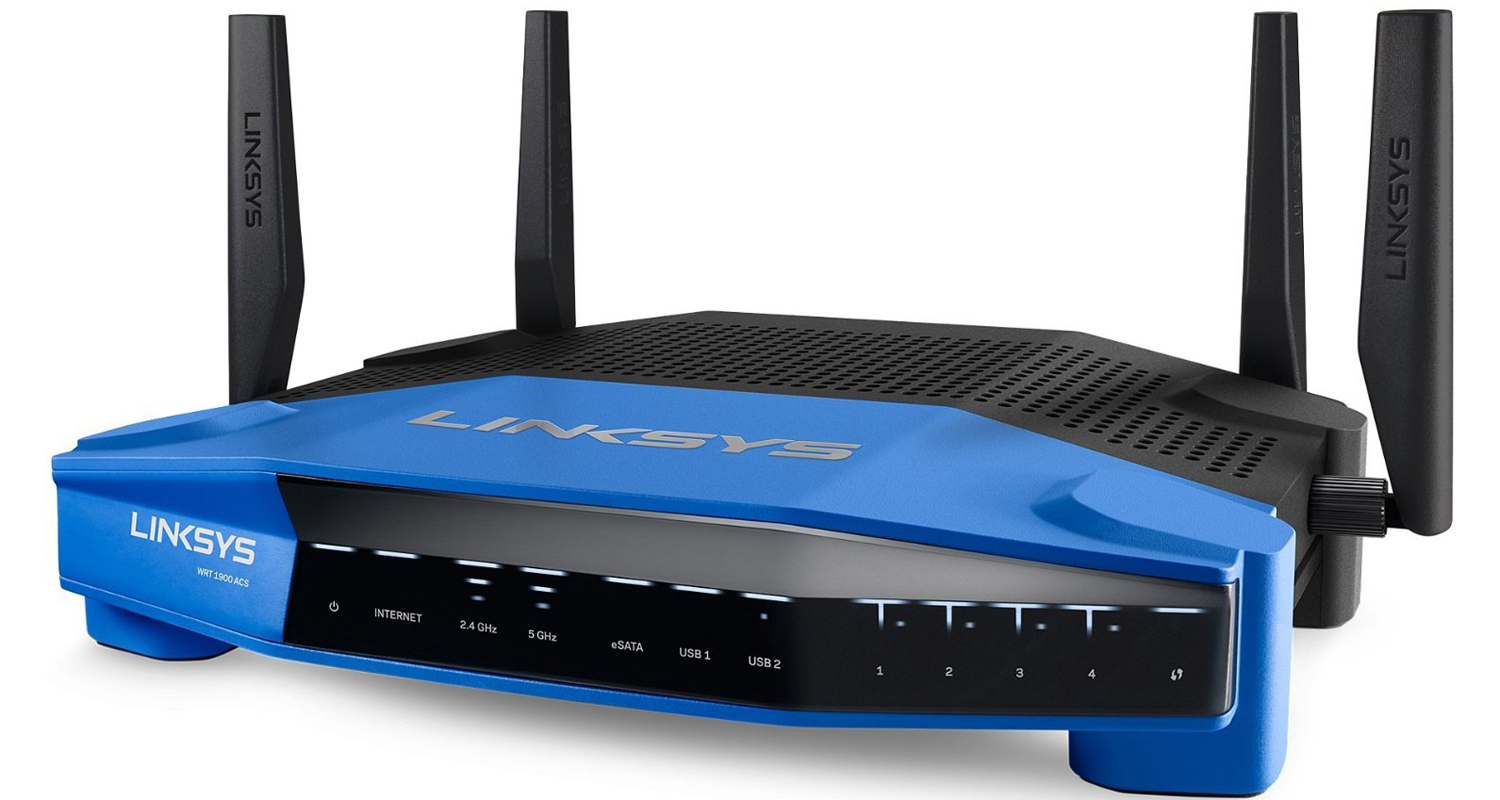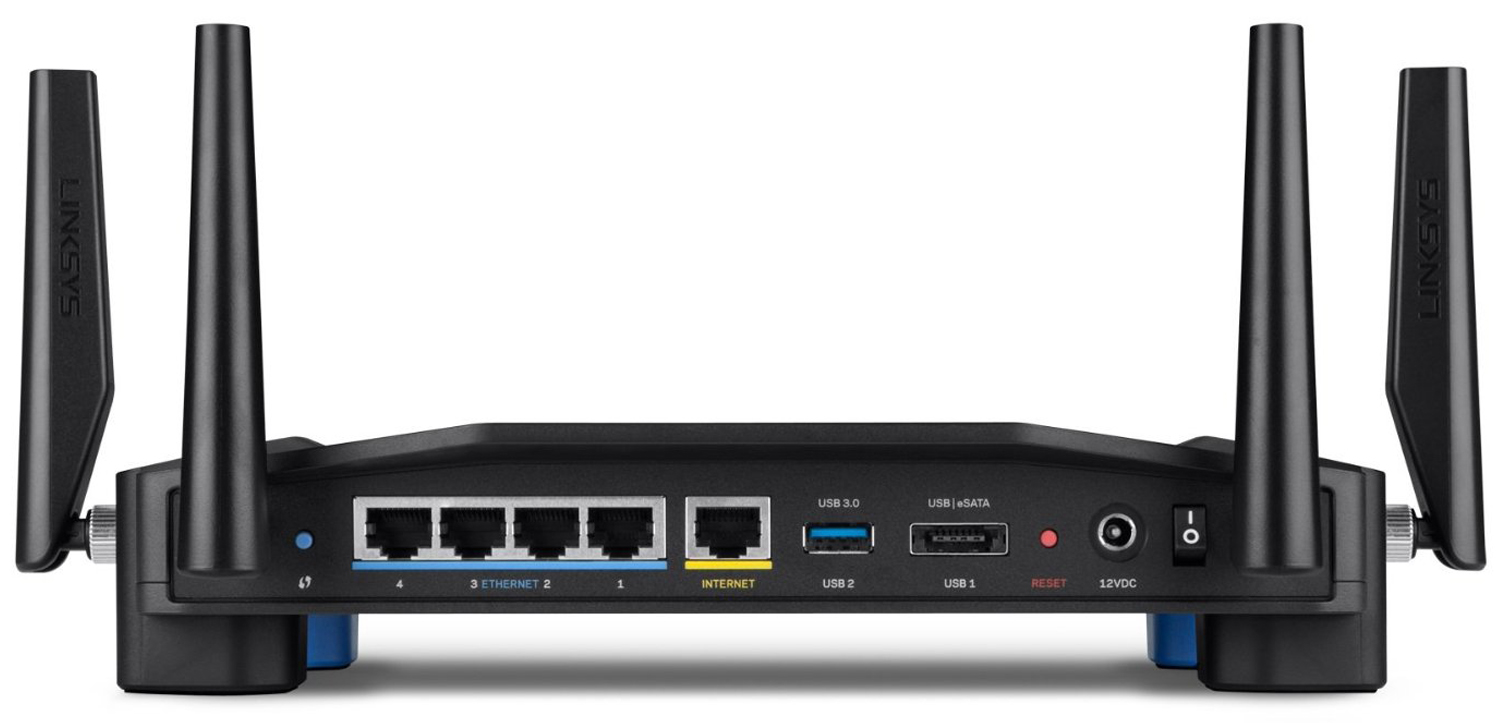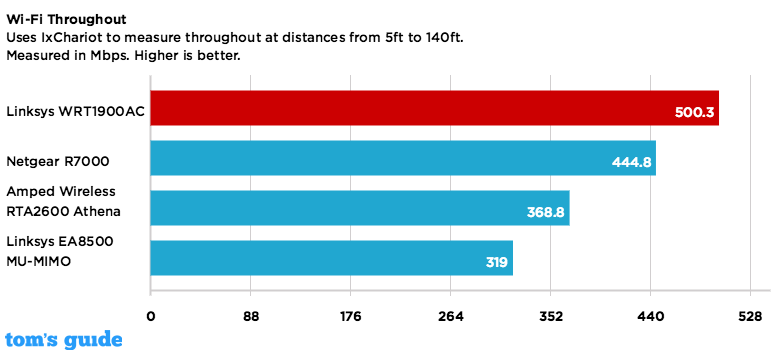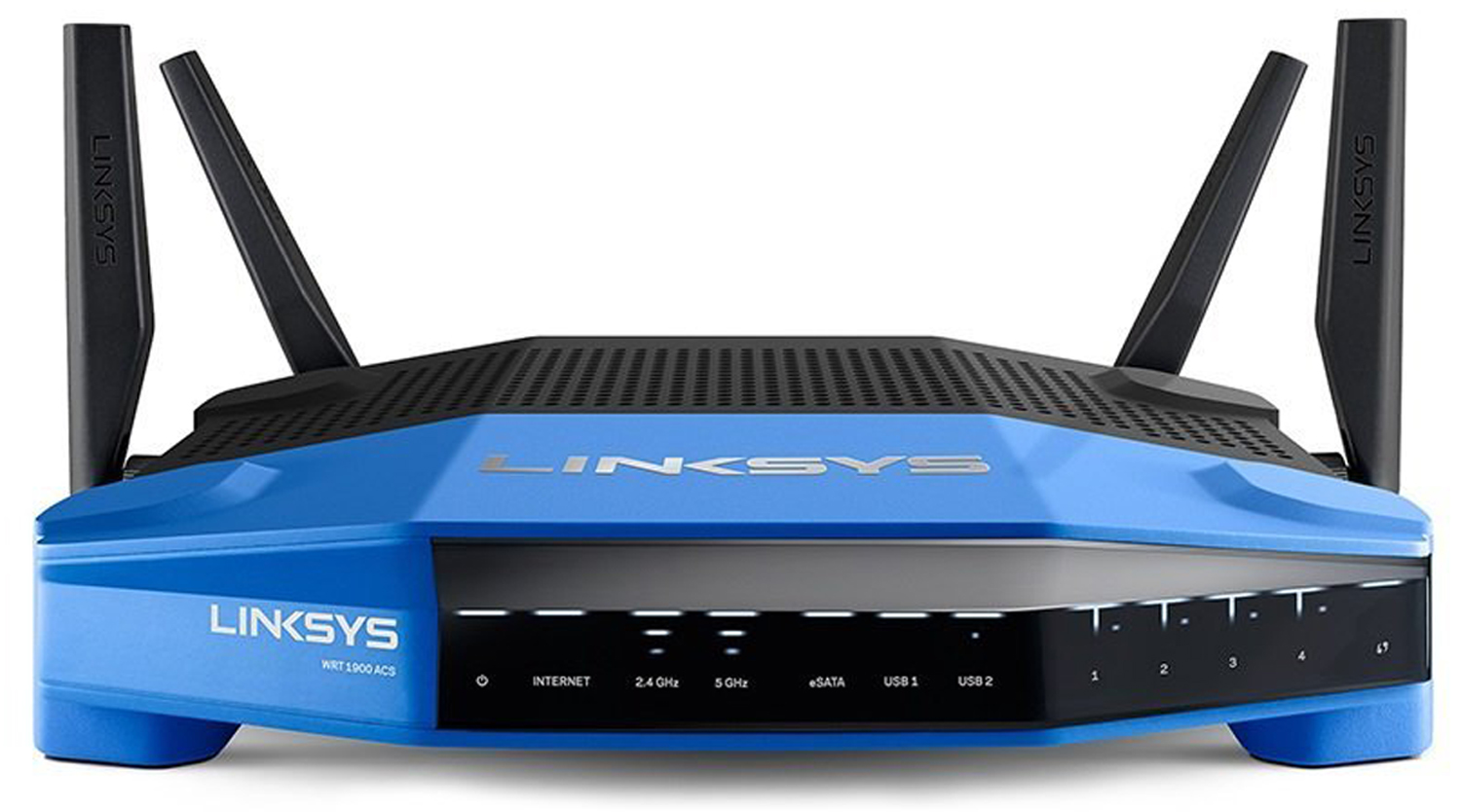Tom's Guide Verdict
The WRT1900ACS blows other routers away with its performance while giving networking experts plenty of ways to configure the device.
Pros
- +
High performance
- +
Fast setup
- +
Useful ports for connecting devices
- +
USB and eSATA ports
- +
Powerful monitoring and management apps
Cons
- -
Bigger than most routers
- -
uninspired design
Why you can trust Tom's Guide
Design
The Linskys WRT1900ACS will provide a feeling of déjà vu for many because the router maker has been using the same basic blue-and-black design for the past two decades. The 1900ACS picks up where the WRT1900AC left off; the new router's broad feet and cutouts match those on other WRT devices, such as Linksys' eight-port switch. This continuity lets you stack your WRT gear.

At 9.7 x 7.6 x 2.0 inches, the WRT1900ACS is one of the biggest routers in its class — in fact, 50 percent larger than Amped Wireless' RTA2600 Athena. An equally large AC adapter can dominate a wall outlet. Despite its size, the WRT1900ACS easily fits on a bookshelf horizontally; you can also mount it on a wall using an included template for drilling the holes.
Like the WRT1900AC, the ACS model comes with four screw-on stubby antennas that you can angle and rotate to optimize reception. Linksys also sells a $100 set of four larger, high-gain antennas that have sensitivities roughly double those of stock antennas.

Rather than a Christmas tree of blinking green, yellow and red lights, the WRT1900ACS' 11 white LEDs are more subdued. They show everything from power and Internet connection to which bands and ports are active. Unlike with the Athena router, though, there's no way to turn the WRT1900ACS' lights off.
MORE: Top-Rated Wi-Fi Extenders to Boost Your Signal
The router's back has an on/off switch, a reset button and a Wi-Fi Protected Setup (WPS) key for adding Wi-Fi devices. There are five Gigabit Ethernet ports: one for connecting your broadband modem and four output ports for connecting to wired networked devices such as computers, switches and storage. I like that the WRT1900ACS also has a USB 3.0 port, as well as a combo port that can work with either eSATA or USB 2.0 connections for external hard drives and printers.
Performance
The WRT1900ACS' dual-band electronics can handle four independent lanes of data traffic. Theoretically, it's capable of moving up to 600 Mbps in 2.4-GHz mode and 1,300 Mbps in 5-GHz mode, for a total peak performance of 1.9 Gbps. The WRT1900ACS uses advanced beamforming technology to squeeze every last megabyte out of its wireless signal. However, it lacks MU-MIMO capabilities for more efficient traffic management — a feature other new routers, such as Linksys' EA8500, do have.
Get instant access to breaking news, the hottest reviews, great deals and helpful tips.

In real-world testing using Ixia's IxChariot software in a crowded Wi-Fi environment, the Linksys WRT1900ACS blew away the competition, including AC2300 routers, which you'd expect to deliver higher data rates. It's the current champ at 5 feet, and can deliver a total throughput of 500.3 Mbps across its two bands. At 15 feet, its 2.4-GHz transmissions hit a peak of 94.7 Mbps, but its 5-GHz broadcasts dropped to 403.8 Mbps, for a total of 498.5 Mbps.
The WRT1900ACS is one of the biggest routers in its class.
That is the best dual-band-router performance we've seen so far, leaving both the more expensive RTA2600 Athena (368.8 Mbps) and the identically priced Netgear R7000 (444.8 Mbps) in the digital dust.
In 2.4-GHz mode, the data flow from the WRT1900ACS dropped to 77.1 Mbps and 21.0 Mbps at 50 and 140 feet, respectively. In an older suburban house with lots of interference, the router managed a 150-foot range — 20 feet above the average for the past year of Tom's Guide router reviews.
Some users of the WRT1900AC and ACS models have reported that the 5-GHz portion of the router shuts down if there isn't enough activity; a few users reported that they were able to fix this by switching from AC-only operations to Mixed Mode. I didn't run into this problem when testing the WRT1900ACS, which was running the most recent version of Linksys' firmware.

The WRT1900ACS worked well over a couple of weeks of daily use with devices ranging from a Microsoft Surface 3 tablet and an iPad Pro to a Samsung TabPro S and an early MacBook Air. The WRT1900ACS successfully streamed a Netflix movie to one device while others were viewing YouTube videos and playing an Internet radio channel, with a fourth system moving data onto and off of a network file server. In other words, even though it does without MU-MIMO technology, the WRT1900ACS should fit in well with a digital home with several data-hungry machines sharing its network.
Setup and Warranty
The versatile WRT1900ACS can be set up as a traditional wireless router, a network extender or an access point. After you've screwed in the antennas, plugged the router into your broadband modem and powered up the system, the WRT1900ACS checks out and optimizes the connection.
In real-world testing, the Linksys WRT1900ACS blew away the competition.
After a minute of setting up the device, I was online. Under the router, you'll find the default network name and encryption passcode. Both are randomized for extra security, but you should still change them immediately. The router comes with a CD that contains a thorough manual, and the cover has places for your personal settings for posterity.
MORE: Don't Rent Your Router: Here Are the Best to Buy
Linksys stands by its WRT1900ACS router with a two-year warranty. That's better than Amped Wireless' scant one year of coverage, but doesn't compare to TRENDnet's lifetime warranty for its routers.
Customization
Unlike with Google's OnHub, you can configure the WRT1900ACS via a Web browser or with the Linksys iOS or Android Smart Wi-Fi app. With the browser-to-router connection, you can make a multitude of changes, from network names for 2.4- and 5-GHz connections to the encryption type and security codes.
You can set up the router to broadcast 2.4- or 5-GHz transmissions, both or neither, and use it as a wired router. The WRT1900ACS is equally fluent in Internet Protocol versions 4 and 6, so it should be many years before it becomes technologically obsolete.
Dig a little deeper, and you can satisfy your inner geek (if you have one) by picking channel width and giving one client, app or game priority over the others.
At any time, you can check the router's performance with a direct link to Ookla's Speedtest.net site, which shows which server you're connected to, the ping (round trip to and from the server) time, and the upload and download speeds.

The Linskys Smart Wi-Fi apps are available for Android and iOS devices and require 10MB of space. With these apps, you can do almost everything that the browser-based interface provides, except using Speedtest.net, or configuring the external storage or the VPN server.
If you don't like any of this, you can use OpenWrt firmware to change the interface's look and add new abilities. But be warned: Using any non-Linksys software voids the WRT1900ACS's warranty.
Security and Parental Controls
The WRT1900ACS has built-in parental controls that allow you to schedule network access and block specific sites. The WRT1900ACS can create two guest networks, which are perfect for gaming parties (or parties of any kind) because they limit the number of clients on the network and fence off the network's individual computers and storage.
Dig a little deeper, and you can satisfy your inner geek by picking channel width and giving one client, app or game priority over the others.
The WRT1900ACS has a stateful packet inspection firewall to separate it from the unruly world of the Web. To secure itself, the router uses everything from the antediluvian WEP to WPA2 Enterprise encryption. It can authenticate clients with a RADIUS server at a small business and be used as a virtual private network server for secure communications.
Bottom Line
While it lacks some of the bells and whistles found in other routers, such as support for MU-MIMO, the Linskys WRT1900ACS delivers data with to throughput and extensive range. You can customize it to your liking or even use open-source software. All of these characteristics make the $229 Linksys WRT1900ACS a high-performance value that should be in your living room.
Brian Nadel is a freelance writer and editor who specializes in technology reporting and reviewing. He works out of the suburban New York City area and has covered topics from nuclear power plants and Wi-Fi routers to cars and tablets. The former editor-in-chief of Mobile Computing and Communications, Nadel is the recipient of the TransPacific Writing Award.
-
johnnytucats I've had a WRT1900AC (v1) for 17 months now and I've been disappointed three ways.Reply
First, the thing has been wonky with connections dropping...both wireless and wired. A router restart always fixes it but who wants to do that even once a week?
Second is the subject of VPN servers. You can NOT host a PPTP or L2TP server behind this thing. It will NOT allow it. There's no documentation on this so I wasted a lot of effort troubleshooting before finding out it couldn't be done. Ridiculous! So I was very excited to see an OpenVPN server added to the firmware as the original firmware didn't include it. Well, it works, but it doesn't work as "send all traffic via VPN" with your client making it worthless to me. When I leave town I have to switch out with my old router to have a full VPN experience back to my home.
Third is the current state, after months and months of versions being released, of OpenWRT and DD-WRT firmware versions for this thing. I've tried them out a few times but they're quite "buggy" and also do NOT seem to correct the VPN issue mentioned in #2.
I say stay away from these. Considering the price I give it a 6 out of 10. -
cj100570 I absolutely love my WRT1900ACs. It worked fine in stock form but I'm never content with stock so I flashed DD-WRT onto it and now it's absolutely amazing. I have it setup as media server using MiniDLNA as well as using Samba to connect to the 3TB hard drive I have attached to it. And as icing on the cake, I have it setup to use my VPN for secure access to the web.Reply -
Blueyed1 Had this router, I was very nice, but sadly it had some serious issues with frequently rebooting, that never got solved. So I returned it.Reply -
Haloan I bought this router on the strength of this review and the reputation of the site. Then I found problems with it and returned it. That's the last time I buy a router based on a positive review without doing more due diligence!Reply
When I was setting up the router and testing it I was horrified to discover that the guest network was not secure. No encryption and the “password” is entered on a non-secure web page. It’s like you’re signing onto an open network in a hotel or coffee shop where you gain access by accepting terms and conditions. It is not only unprofessional for a company like Linksys it’s completely (and I want to use a really bad word here but instead I’ll say) ABSURD!!!! I googled it and found a number of publications and people had written articles about this oversight. If you need a guest network, THEN DON’T BUY THIS ROUTER!!! If you don’t use one and never will, then feel free. I also read an article which said that 15 days ago from the day I set it up (5/5/17), multiple security vulnerabilities were discovered in the Linksys line of routers including this one, and until new firmware was released (the most up to date one I downloaded was released 6 months ago), the fix was to shut off the guest network. Which I had already done when I discovered it was insecure.
Of course this router allows open source firmware to be used and so there may be ones out there which allow you to create secure guest networks. I spent a little time reading about that but decided that it’s complex and time consuming enough that I really don’t have the time to deal with that. I would rather just return it and buy a good enough router with better firmware!
In other testing I found that the router didn’t bother to find the best channel for the “legacy” 2.4GHz N band. Thus the signal strength was weak. I could have gone into the router and changed the channel. But first you need a tool to be able to look at all the networks in the area and which channels are being used. I have a couple of those tools from the two adapters I was using and testing. In addition, the 5GHz N band, while the adapter said it connected at a higher speed, the actual speed in a speed test was still as slow as the 2.4 GHz.
But we really didn’t buy this router for its legacy N broadcast right? Well except for all the older devices sitting around the house which can only utilize 2.4 GHz N. -
daddywalter I bought this model's big brother, the WRT3200ACM, refurbished direct from Belkin/Linksys a couple of months ago -- at only $99US I couldn't pass up the deal. So far it's been rock-solid, giving faster and more reliable connections than the Linksys EA4500 it replaced.Reply
Yes, it's larger than most comparable routers, but I knew that before I bought it and I actually like the size. As for the design, I consider it "tech-industrial" rather than "uninspired". (In truth, the design is inspired by the classic original WRT Wi-Fi routers, which are still highly regarded after all these years.) It doesn't blend well with the decor in the average living room, but it's fine for a dedicated office/computer room.
I gave the old EA4500 to my style-conscious girlfriend, who was switching ISPs (from verrry slow DSL to cable) and needed to provide her own modem and router.It still works fine, and fits in well with the decor in her study She's on a slower broadband tier than I am, so an N-class router is more than adequate for her needs;
I'm actually looking to upgrade to a faster service (possibly Gigabit fiber) in the future, and I have a much more extensive home network than she does; I don't actually need the WRT3200ACM's full capability, but it should help keep me future-proof for awhile. And it adds a welcome dash of color to an office dominated by dark wood and black boxes.


